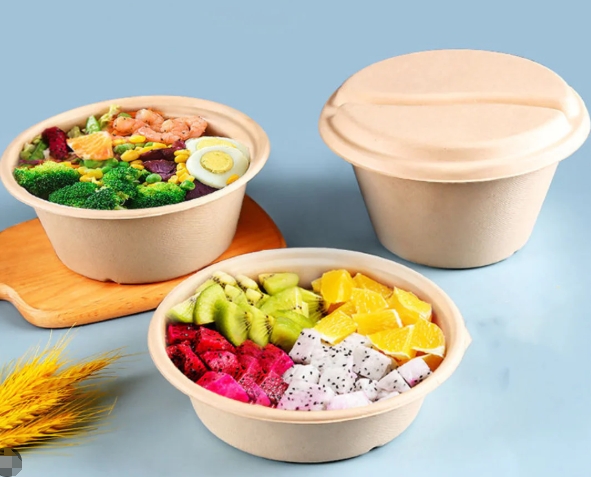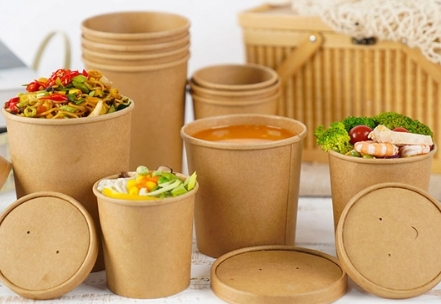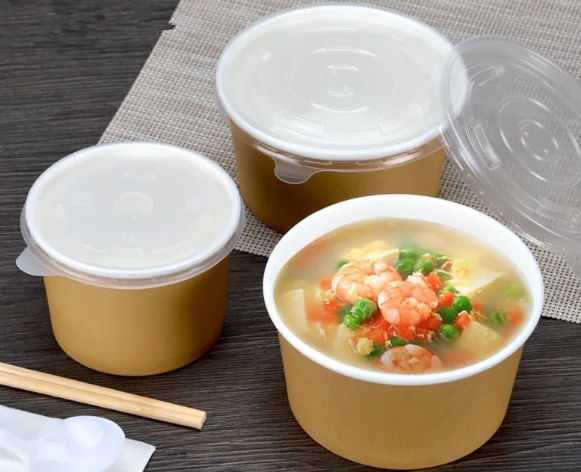
Content Menu
● Understanding Eco-Friendly Materials
>> What Defines Eco-Friendly Materials?
>> Popular Sustainable Materials for Bowls and Lids
● Assessing Your Restaurant's Needs
>> Menu Considerations
>> Dine-In vs. Takeout
>> Brand Image and Customer Expectations
● Comparing Bowl and Lid Features
>> Durability and Strength
>> Heat and Microwave Resistance
>> Compostability and Biodegradability
>> Recyclability
● Sourcing and Cost Considerations
>> Supplier Reliability
>> Cost vs. Value
>> Bulk Purchasing and Customization
● Regulatory Compliance
>> Food Safety Standards
>> Local Composting and Recycling Guidelines
● Enhancing Customer Experience
>> Ease of Use
>> Presentation
>> Communication
● Case Studies: Success Stories from Eco-Friendly Restaurants
>> Case Study 1: Fast-Casual Salad Bar
>> Case Study 2: Gourmet Takeout Bistro
● Tips for Making the Right Choice
● Conclusion
● FAQ
>> 1. What are the most sustainable materials for restaurant bowls and lids?
>> 2. How can I ensure my bowls and lids are truly compostable?
>> 3. Are eco-friendly bowls and lids suitable for hot foods?
>> 4. How do I balance cost and sustainability when choosing packaging?
>> 5. What should I communicate to customers about my sustainable packaging?
Eco-friendly restaurants are more than just a trend—they are a response to the growing demand for sustainability and environmental responsibility in the food industry. One of the most significant ways your restaurant can make a positive impact is by carefully selecting the right bowls and lids for serving and packaging food. The right choices not only reduce your environmental footprint but also enhance customer satisfaction, reinforce your brand identity, and demonstrate your commitment to a greener future.
This comprehensive guide will help you navigate the process of choosing the most suitable bowls and lids for your eco-friendly restaurant. We will explore sustainable materials, practical considerations, supplier relationships, regulatory compliance, and customer experience, providing actionable insights to help you make informed, responsible decisions.

Understanding Eco-Friendly Materials
What Defines Eco-Friendly Materials?
Eco-friendly materials are those that minimize harm to the environment throughout their entire lifecycle—from sourcing and manufacturing to use and disposal. Key attributes include:
- Sourced from renewable or rapidly replenishing resources
- Biodegradable or compostable after use
- Recyclable in existing waste management systems
- Manufactured with minimal energy and water consumption
- Free from toxic chemicals and additives
Popular Sustainable Materials for Bowls and Lids
- Bamboo: A fast-growing, renewable resource that is both strong and biodegradable, making it ideal for sturdy bowls and lids.
- Sugarcane Bagasse: This fibrous byproduct of sugar production is compostable and heat-resistant, suitable for both hot and cold foods.
- Palm Leaf: Made from naturally fallen palm leaves, these products are pressed into shape, offering a rustic, compostable option.
- PLA (Polylactic Acid): Derived from fermented plant starch, PLA is compostable under industrial conditions and is often used for clear lids.
- Recycled Paperboard: Made from post-consumer paper waste, it is recyclable and sometimes compostable if uncoated.
- Wheat Straw: A byproduct of wheat harvesting, this material is durable, lightweight, and compostable.
Assessing Your Restaurant's Needs
Menu Considerations
The type of food you serve will greatly influence your choice of bowls and lids. Consider the following:
- Hot vs. Cold Foods: Ensure that the materials you choose can withstand the temperatures of your menu items without warping or leaching.
- Liquids and Sauces: Soups, stews, and curries require leak-proof, sturdy containers that prevent spills.
- Portion Sizes: Select bowl sizes that match your serving portions to minimize waste and ensure customer satisfaction.
Dine-In vs. Takeout
- Dine-In: Focus on reusable or highly durable compostable options for a premium dining experience.
- Takeout/Delivery: Prioritize containers that are leak-proof, stackable, and have secure lids to maintain food quality and presentation during transport.
Brand Image and Customer Expectations
Your choice of packaging is a direct reflection of your brand. Eco-conscious customers appreciate transparency and visible commitment to sustainability. Consider custom printing or labeling your bowls and lids to communicate your values and educate customers about the materials used.
Comparing Bowl and Lid Features
Durability and Strength
Bowls and lids must withstand the rigors of transport, stacking, and handling. Test your options for:
- Resistance to cracking, breaking, or deforming
- Ability to hold hot, cold, or oily foods without leaking
- Secure lid fit to prevent spills and maintain freshness
Heat and Microwave Resistance
Not all eco-friendly materials are microwave safe. If your customers may reheat food, ensure your bowls and lids can handle it without deforming or releasing harmful substances.
Compostability and Biodegradability
Look for third-party certifications that verify compostability. True compostables break down into non-toxic components in a commercial composting facility, while biodegradable items may take longer and require specific conditions.
Recyclability
Some materials, such as clean paperboard or certain plastics, can be recycled in many municipal programs. However, contamination with food residue can limit recyclability. Educate your staff and customers on proper disposal practices to maximize environmental benefits.
Sourcing and Cost Considerations
Supplier Reliability
Work with suppliers who are transparent about sourcing, certifications, and supply chain practices. Reliable partners help ensure consistent quality, timely delivery, and ongoing support.
Cost vs. Value
Eco-friendly options may have higher upfront costs, but they can deliver long-term value through:
- Enhanced brand reputation and customer loyalty
- Reduced waste disposal fees
- Potential eligibility for green certifications and government incentives
Bulk Purchasing and Customization
Ordering in bulk can reduce per-unit costs. Many suppliers offer customization options, such as branded printing or unique shapes, which can further reinforce your restaurant's image and message.

Regulatory Compliance
Food Safety Standards
All bowls and lids must meet food safety regulations. Ensure materials are free from harmful chemicals such as BPA, PFAS, and phthalates, and are suitable for direct food contact.
Local Composting and Recycling Guidelines
Check with local waste management authorities to ensure your chosen materials are accepted in commercial composting or recycling streams. Compliance with local regulations helps avoid unnecessary waste and supports your sustainability goals.
Enhancing Customer Experience
Ease of Use
Bowls and lids should be easy to open, close, and carry. Consider ergonomic designs and features like vented lids for hot foods to ensure safety and convenience.
Presentation
Attractive packaging enhances the perceived value of your food. Choose shapes, colors, and textures that complement your cuisine and strengthen your brand identity.
Communication
Use packaging or signage to educate customers about the eco-friendly nature of your bowls and lids, and provide clear instructions for proper disposal. This not only encourages responsible behavior but also builds trust in your brand.
Case Studies: Success Stories from Eco-Friendly Restaurants
Case Study 1: Fast-Casual Salad Bar
A salad bar chain transitioned to sugarcane bowls with matching lids, resulting in positive customer feedback about the natural look and feel. The switch also reduced landfill waste, as most customers disposed of containers in compost bins provided on-site.
Case Study 2: Gourmet Takeout Bistro
A bistro specializing in hot meals adopted bamboo fiber bowls and PLA lids. Customers appreciated the sturdy construction and the restaurant's visible commitment to sustainability, leading to increased repeat business and positive word-of-mouth.
Tips for Making the Right Choice
- Test Samples: Order samples and test them with your menu items before committing to a large order.
- Engage Staff: Train your team on the benefits and proper use of new packaging to ensure smooth implementation.
- Gather Feedback: Encourage customers to share their experiences and suggestions for improvement.
- Stay Updated: Monitor industry trends and innovations in sustainable packaging to keep your offerings fresh and competitive.
Conclusion
Choosing the right bowl and lid for your eco-friendly restaurant is a multifaceted decision that affects your brand, customer experience, and the environment. By prioritizing sustainable materials, assessing your operational needs, and staying informed about regulations and innovations, you can make choices that support both your business and the planet. Thoughtful packaging not only protects your food but also communicates your values to every customer you serve, helping to build a loyal customer base and a positive reputation in the community.

FAQ
1. What are the most sustainable materials for restaurant bowls and lids?
The most sustainable materials include bamboo, sugarcane bagasse, palm leaf, PLA, recycled paperboard, and wheat straw. These materials are renewable, compostable, or recyclable, making them ideal for eco-friendly restaurants.
2. How can I ensure my bowls and lids are truly compostable?
Look for third-party certifications such as BPI or OK Compost. These indicate that the products meet recognized standards for compostability and will break down safely in commercial composting facilities.
3. Are eco-friendly bowls and lids suitable for hot foods?
Yes, many eco-friendly options are designed to handle hot foods. Materials like sugarcane bagasse, bamboo, and certain PLA blends can withstand high temperatures without deforming or leaching chemicals.
4. How do I balance cost and sustainability when choosing packaging?
Consider the long-term benefits of sustainable packaging, such as improved brand reputation and customer loyalty. Bulk purchasing and working with reliable suppliers can help manage costs while maintaining eco-friendly standards.
5. What should I communicate to customers about my sustainable packaging?
Clearly label your packaging as compostable or recyclable, and provide instructions for proper disposal. Sharing your commitment to sustainability can enhance customer trust and encourage responsible behavior.

















